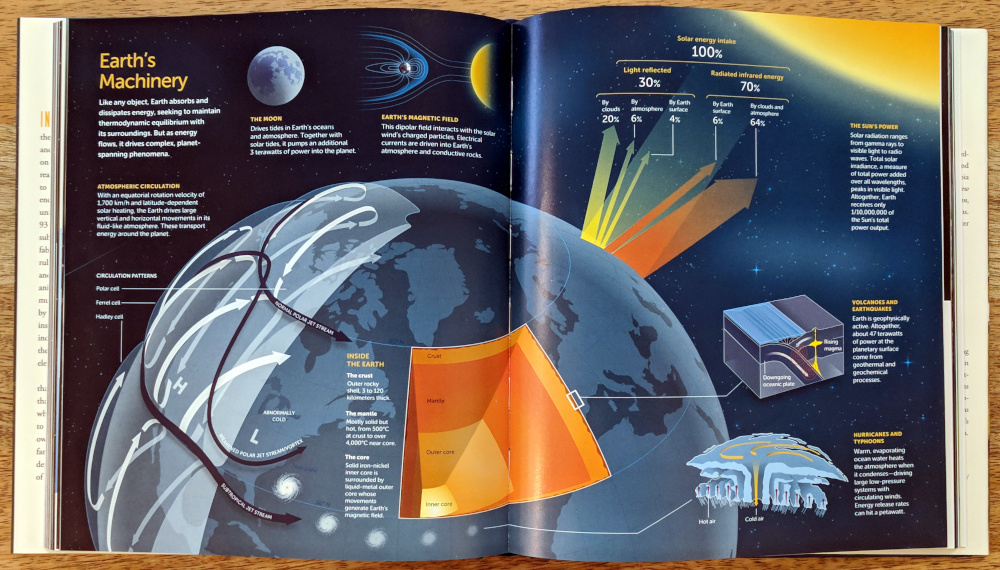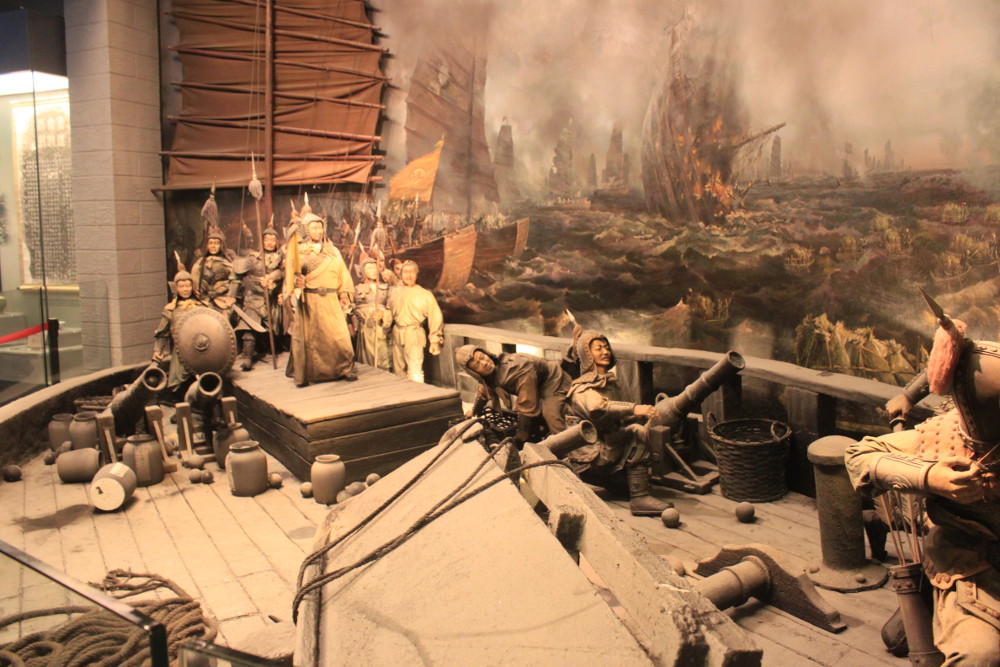Latest reviews
The karaage (fried tofu) tastes amazing, and the sauces are perfect. The food also came extremely fast. The staff (2 people) started to have some problems when the place became more crowded, but everything else about this place, including the ambiance, totally makes up for it.
This free review service looks very promissing, but apparently it lacks an API (application programming interface). So other services have to invent the wheel again and implement their own review system, which is a bit sad. 🤷
Back in 1977, Powers of Ten awed many children and adults alike with a presentation of our scientific understanding of the universe at different orders of magnitude, zooming out from a couple on a picnic blanket to the observable universe, then zooming back in, all the way down to the level of the hypothesized activity inside a single proton. (You can view the 9 minute film on YouTube.)
Astronomer Caleb Scharf’s book The Zoomable Universe updates this approach to our current understanding of the universe, aided by modernized visuals created by illustrator Ron Miller and a graphic design firm.
The book doesn’t start the journey on a picnic blanket, but at an order of magnitude of 10^27 meters—the “diameter of the cosmic horizon”—and ends at 10^-35 meters, the Plack length. At each order of magnitude, Scharf attempts to bring out astonishing facts, while narrating the journey in a conversational style.
Full-page photographs, computer renderings and information graphics support each section of the book. Their quality and aesthetic style are somewhat inconsistent throughout the book, ranging from pretty basic computer renderings of imaginary planets to detailed and striking illustrations like the one below.

Illustration of the different forces at work on planet Earth. (Credit: Caleb Scharf / Ron Miller / SW Infographics. Fair use.)
Scharf’s text is informative, but it’s in the nature of a book like this to provide limited depth on any one topic. The objective here is to create a sense of wonder, and a high level understanding of how the universe operates at different scales. In that sense, the book functions as a kind of paper planetarium.
To Scharf’s credit, he does not shy away from attempting to explain the weird and wonderful world of the subatomic, and the book’s illustration of the famous double-slit experiment and the different interpretations of its results is especially lucid.
The book concludes with a notes section that is very much worth reading, giving additional background on the thinking that went into each section, and pointing to books, papers and websites for further exploration. I give the author high marks for this approach: notes don’t have to be boring!
While I found much of the material in The Zoomable Universe quite familiar, I still appreciated its thoughtful organization and the engaging presentation. I would recommend the book especially for younger readers, or those seeking to re-engage with astronomy, physics and biology (perhaps after a less than stellar experience learning about those subjects in school).
I’ll be honest with you: I rarely enjoy poetry; for the most part, it creates in me only the “feeling that I should be feeling something”. It’s a different story when poetry is set to song or to beautiful illustrations. Perhaps other readers create their own mental melodies when they read mere words; I require the assist.
With The Lost Words, Robert Macfarlane and Jackie Morris have created something even I can appreciate: a book that, through poetry and gorgeous art, invites a profound re-connection with nature.
The premise of the book is that words that refer to the natural world—words like “adder”, “conker”, “otter” and “wren”—are slowly disappearing from the language of children. And surely for many children growing up today, especially in urban environments, this is very true.
To restore these words—and the connection with nature they represent—to our lives, the book invites us to summon nature by reading out acrostic spells. Each poem is set alongside a beautiful full-page illustration showing the subject (e.g., a dandelion plant) in isolation; turn the page, and you’ll discover a two-page watercolor showing the subject again, now within nature. The spell for “bramble” begins as follows:
Bramble is on the march again,
Rolling and arching along the hedges
into parks on the city edges
All streets are suddenly thick with briar:
cars snarled fast, business over.
Moths have come in their millions,
drawn to the thorns. The air flutters.
…
This spell is then followed by an immersive illustration, making the most of the book’s large (27.7 cm x 37.6 cm) format:

Illustration of bramble, from The Lost Words. (Credit: Jackie Morris. Fair use.)
The Lost Words is not a science book; it does not provide explanation or context. In the beauty of its spells and illustrations, it builds something arguably even more important: the emotional foundation for our interest in nature. We will fail to conserve what we do not care about.
There is no doubt that Morris and Macfarlane have created a masterpiece, a timeless work that can be enjoyed by all ages. It is a book of few words, and it invites meditative reflection more than reading. I expect to pick it up again when it’s too cold and rainy outside to take a walk, but I still long to kindle my memory of the beauty of the natural world.
I ordered an X200 Thinkpad from MiniFree in Jan 2019. Minifree is one of the very few companies selling truly free (as in freedom) laptops, including bios (thanks to the Libreboot project) & drivers.
First off, I want to highlight that my order got shipped very quickly – on the same day the payment was received. Communication from beginning to end was also very good, always clear, on time and professional. The parcel arrived in just a few days even though I am located in a different country. The items – the laptop and its docking station – were both very carefully packaged.
Even though it’s a reconditioned item, the laptop looks almost new and performance is good. It was usable right away since it comes installed with Trisquel, a very easy-to-use GNU/Linux distribution approved by the Free Software Foundation – no installation or configuration needed.
One of the things that I especially liked is the hardware kill switch for wifi/bluetooth. Also the docking station includes an optical DVD/CD drive, something that has almost disappeared nowadays but that I still need from time to time.
I am very satisfied with the products and the service. I will definitely buy from Minifree again!
At the end of Adam Rutherford’s A Brief History of Everyone Who Ever Lived, we find an interview with the author. In it, he explains his writing process:
This may sound incredibly pretentious, but I write, and it only becomes clear to me what the point is about three quarters of the way through any particular section. (…) Fiction writers sometimes say that they don’t know what their characters are going to do next, and they are surprised when it happens. I feel like that sometimes in my writing.
It doesn’t sound pretentious to me, it’s just not a coherent way to organize history, especially not a project as ambitious as the one Rutherford is ostensibly attempting (the subtitle promises “The Human Story Retold Through Our Genes”).
What this book delivers is, instead, the following:
-
an overview of how our hard-won ability to sequence the DNA of the living and the long-dead has given us new insights into the history of early humans, including the inter-breeding of Homo sapiens with Neanderthals and of Neanderthals with Denisovans;
-
examples of anthropological and cross-disciplinary research projects utilizing DNA, with a somewhat parochial emphasis on British examples such as the People of the British Isles research project, and the discovery and DNA analysis of Richard III;
-
arguments on the limitations of DNA research, especially at the individual level, and about the pseudoscience of racial divisions;
-
a discussion of historical and ongoing evolution of humans;
-
a fair bit of griping about misrepresentations of science by media, corporations, and assorted charlatans, some sniping at creationists, and a bit more inside knowledge about Adam Rutherford himself than most readers are likely to require.
Rutherford is a geneticist and a presenter of science documentaries; he views himself as a storyteller, and if what you’re looking for is a casual, conversational and occasionally funny read about the (more or less) current state of genetics, as well as some solid debunking of racist nonsense, this is a fine book.
It is not, however, a well-organized history of humankind “retold through our genes”, nor is the writing so consistently good and entertaining to make up for this lack of organization. 3 out of 5 stars—there was enough new science for me to not give up on the book, but I would only recommend it with reservations.
Broken Age is a game that helped define the Kickstarter era by raising a record-breaking $3.45M in independent funding. Much of that support can be attributed to the love many now adult gamers still have for classic point-and-click adventure games that project instigator Tim Schafer worked on in the 1990s (Full Throttle, Day of the Tentacle, and others). Inevitably, a fair amount of Kickstarter drama followed which overshadows many reviews you’ll find online.
This review is written from the perspective of a point and click adventure fan who played the game well after its original release—I bought it for less than $5 during Gog’s winter sale. As of this writing, it’s back at $15, but you can wishlist the game to be alerted when the price comes down. It’s available for many platforms, including Linux and the Nintendo Switch.
Broken Age follows in the tradition of the genre, but unlike other entrants like Thimbleweed Park (review), it eschews pixel art in favor of a more modern look and feel. The world of Broken Age is beautifully drawn and animated, and none other than Elijah Wood (Lord of the Rings) lends his voice to one of the two lead characters, Shay.
The story is told from the perspective of Shay and Vella, who live very different lives. Shay lives on a spaceship whose computer coddles and infantilizes him. Meanwhile, Vella is a young girl apparently destined to be sacrificed to a horrific monster in a ceremony called the “Maiden’s Feast”, which is meant to prevent the monster from destroying the whole town.

During dialog sections, the game zooms in on the character who’s speaking. Key characters are voiced by well-known actors like Elijah Wood and Wil Wheaton. (Credit: DoubleFine. Fair use.)
As the player, you can switch between the two characters, and you will eventually learn how Shay’s and Vella’s lives are connected. The story is told with a lot of humor, and the full-screen art and professional voice acting create an immersive feel. The game respects the Fourth Wall and avoids gaming humor, instead inviting you to focus fully on the story.
The controls are simple—you can access your inventory at the bottom of the screen when needed, and click items or characters to interact with them—but that doesn’t mean that the game is too easy. The puzzles get progressively more difficult, and for the most part, they do make sense: pay attention to what characters are saying and what you’re seeing on the screen, and you can figure things out.
This changes towards the end of the game, when some very tricky puzzles depend on illogical knowledge-sharing between the two characters, and the characters’ goals become confused and confusing. In short, the ending of the game feels a bit rushed and underwhelming, which is a shame because the overall story is both clever and interesting.
Regardless, this is a game with a lot of heart that advances the genre rather than just wallowing in nostalgia. It’s great fun to explore its worlds, interact with the quirky characters, and unravel the central mysteries of the story. I reached for a walkthrough during the frustrating parts, and overall got more than 10 hours worth of fun out of my $5 investment.
4.5 out of 5 stars, rounded up because the good parts are really good, and the game represents a step forward for the point-and-click genre, especially in its art direction.
The place to go to find Prusa mods and the people who made them. Everybody is generally helpful and willing to answer questions.
Hub for several mods for the i3 MK3 including the Bear project and skelestruder.
In the United States, the term “liberal” has become associated with the soup of center-left to center-right ideas promoted by the US Democratic Party, and it would be overly generous to ascribe to those ideas any coherent ideological foundation. Historically, liberalism (or “classical liberalism”) has a more specific meaning and is linked to the writings of figures like John Locke, Adam Smith, John Stuart Mill and Alexis de Tocqueville.
The importance of understanding what these individuals truly said and did has been elevated by what The Baffler called the “Classical Liberal Pivot”, the attempt by reactionaries ranging from outgoing GOP Speaker of the House Paul Ryan to InfoWars alumnus Paul Joseph Watson to frame their ideas through reference to a past most people only have a patchwork knowledge of.
Liberalism: A Counter-History by Domenico Losurdo (d. 2018) was published in 2011 and limits itself largely to the analysis of liberal thought up to the 20th century, with occasional reference to 20th century writers like Friedrich Hayek and Ludwig von Mises. As a counter-history, it intends to focus on the less well-known aspects of liberal ideology.
In particular, the book is concerned with how liberal ideology frequently defined civilization and humanity precisely in such a way as to support the goals of regional power elites at the time: to maintain and extend the system of slavery in the American South, to displace or exterminate Native Americans, to commit atrocities in French Algeria, Ireland or the British colonies, to coerce the poor into labor or military service, and so on.
To support this thesis, Losurdo primarily cites the writings of liberals themselves. Let’s work backwards: von Mises, a hero to free market libertarians, wrote in Liberalism, published in 1927:
It cannot be denied that Fascism and similar movements aimed at the establishment of dictatorships are full of the best intentions and that their intervention has for the moment saved European civilization. The merit that Fascism has thereby won for itself will live on eternally in history.
The Mises Institute complains bitterly that this quote is taken out of its context (in context, von Mises views Fascism as an “emergency makeshift”), but it’s hard to say how any celebration of Fascism’s eternally won merit can be rescued by context. This quote may be surprising, but it is mild stuff compared to the ideas of de Tocqueville, who celebrated the Opium War (a war waged by Britain to force China to buy opium!) with these words (emphasis mine):
I can only rejoice in the thought of the invasion of the Celestial Empire by a European army. So at last the mobility of Europe has come to grips with Chinese immobility! It is a great event, especially if one thinks that it is only the continuation, the last in a multitude of events of the same nature all of which are pushing the European race out of its home and are successively submitting all the other races to its empire or its influence. Something more vast, more extraordinary than the establishment of the Roman Empire is growing out of our times, without anyone noticing it; it is the enslavement of four parts of the world by the fifth. Therefore, let us not slander our century and ourselves too much; the men are small, but the events are great.

First Opium War display in the Shenzhen Museum. Alexis de Tocqueville celebrated the war as part of “the enslavement of four parts of the world by the fifth”. (Credit: Huangdan2060. Public domain.)
How can such ideas be reconciled with any concept of “liberty”? Losurdo unpacks this contradiction masterfully. Liberalism has consistently resolved the contradiction by defining the world into a “sacred” and a “profane” space. The “sacred” space is the one where liberty has to to be defended against despots; the “profane” space is that occupied by people who are inferior, less than human, “wild beasts”, rightly conquered, justly enslaved.
This profane space was reserved for women, the native populations of countries subjected to settler-colonialism, the Africans abducted in murderous journeys to serve as slaves in the colonies, people convicted of crimes (however immoral the basis of the conviction), the poor, the disabled, and so on, and so forth.
And it is with this distinction in mind we can understand that John Locke, “the father of liberalism”,
regarded slavery in the colonies as self-evident and indisputable, and personally contributed to the legal formalization of the institution in Carolina. He took a hand in drafting the constitutional provision according to which ‘every man of Carolina shall have absolute power and authority over his Negro slaves, of what opinion or religion soever.’ Locke was ‘the last major philosopher to seek a justification for absolute and perpetual slavery’. However, this did not prevent him from inveighing against the political ‘slavery’ that absolute monarchy sought to impose. [p. 3]
Perhaps nowhere was the contrast between rhetoric and reality more stark than in the American Revolution—a revolution in significant part undertaken to continue America’s genocidal expansion westward (which the British sought to limit), while perpetuating a horrific regime of hereditary chattel slavery. It is for these reasons that Losurdo refers to the new American nation as a “master-race democracy” and calls racial chattel slavery and liberalism a “twin birth”.
Losurdo quotes Theodore Roosevelt, who called “the inability of the motherland country to understand that the freemen who went forth to conquer a continent should be encouraged in that work” the “chief factor in producing the Revolution”; Roosevelt complained that Britain wanted to “[preserve] the mighty and beautiful valley of the Ohio as a hunting-ground for savages”. [p. 303]
Yet, it was the rhetoric of the American Revolution that inspired the French Revolution, which in turn inspired the Haitian Revolution by self-liberated slaves. Fearful that such an authentic struggle for liberty might lead to slave rebellions in the United States, Thomas Jefferson assured a French diplomat that “nothing would be easier than to furnish your army and fleet with everything, and to reduce Toussaint to starvation”. When the revolution ultimately succeeded, Jefferson imposed a crippling embargo that would last nearly 60 years.
Losurdo contrasts liberalism with the “radicalism” of the Haitian and French revolutions. It was precisely people in the liberal tradition who often argued and fought against broad liberation, whether it’s the abolition of slavery or the expansion of suffrage, limits on working hours and child labor, the recognition of trade unions, and so on. As new rights were won, the line between “sacred” and “profane” spaces shifted.
The author acknowledges that liberalism is, above all, an ideology adaptable to its time and place. Few “neoliberals” would argue for the re-introduction of child labor in wealthy countries, but many would describe horrific labor conditions in the rest of the world as a necessary evil (or even positive good) that’s part of economic development. Here we see a similar division of the world into “sacred” and “profane” spaces, but under greatly altered parameters.
The Verdict
Like many other academic writers, Losurdo is inclined to repetition, though to his credit, he often reinforces earlier arguments with new material. References to writers, historical figures and events are introduced rapidly, and I found myself looking them up on Wikipedia more than once to get my bearings.
A more serious criticism of the book is its uncritical use of derogatory terms like “redskins” throughout, and its relative silence on the role of women (and the patriarchal aspects of liberal ideology). Moreover, Losurdo makes no serious effort to draw the connections and parallels between “classical liberalism” and modern liberal or libertarian thought.
Nonetheless, if we want to recognize the patterns of history in the present day, we have to first know what these patterns are. Liberalism: A Counter-History is an important contribution to recognizing the rhetoric of liberation that may overshadow, or even enable, the oppression of those not included in its “sacred space”.
Among the 50 U.S. states, Mississippi has the lowest per-capita GDP and the highest poverty rate when not adjusted for cost-of-living. The state capital, Jackson, is about 80% Black or African-American; the city was named after slave-owner president Andrew Jackson who once placed an ad for the capture of a runaway slave promising “ten dollars extra, for every hundred lashes any person will give him, up to the amount of three hundred”.
Given the present and historical context, the election of Chokwe Lumumba as Jackson’s mayor, followed soon after his death in 2014 by that of his son Chokwe Antar Lumumba, upon a radical platform of political and economic liberation may defy stereotypes about the Deep South. But it is from the history of enslavement, terror and oppression that liberation movements emerged.
Cooperation Jackson is the movement that helped elect the Lumumbas, and which is seeking to build a bottom-up, co-operative economy not just in Jackson, but in the entire black-majority cross-state area referred to as the Kush (after an ancient African kingdom). Beyond its co-op elements, the movement seeks to mobilize the local community through assemblies to enact changes on the ground and to push for social and economic liberation.

In the early 1970s, the Provisional Government of the Republic of New Afrika planned for the Kush District to serve as power center for a new black-led nation in the South. (Credit: Republic of New Africa. Fair use.)
In practice, this vast ambition translates into much more tangible projects—urban farming and efforts to co-operatively run restaurants, grocery stores, and a fabrication center, for example.
Jackson Rising is a collection of essays dating to different points over the last few years, describing practical progress and laying out the movement’s vision for the future. The tension between what the movement seeks to achieve and what it can realistically accomplish with limited resources is palpable, and Cooperation Jackson’s recently published 2018 in Review describes the challenges of maintaining a coherent movement in light of these fundamental obstacles and ideological tensions within the movement.
The book can only be understood at offering snapshot insights into this ongoing experiment. The assortment of essays unfortunately suffers from a fair bit of repetition (the story of the elder Lumumba’s death in office, and the movement’s efforts to pick up from this this setback, is re-told multiple times, for example), and not all essays add much to the reader’s understanding.
One definite highlight of the book is the essay by Jessica Gordon Nembhard about the history of African American co-operative economic efforts, which were often a form of mutual aid in the face of terror, segregation and oppression. In her book Collective Courage, Nembhard offers a more detailed account of this history.
If you don’t end up picking up a copy of Jackson Rising but want to learn more about Cooperation Jackson, I recommend reading the online version of another article that’s included in the book: “The Socialist Experiment” by Katie Gilbert (Oxford American, September 5, 2017). It encapsulates the movement’s work up to the time it was published very well, without glossing over the enormous challenges of transforming a city’s economy from the bottom up.
